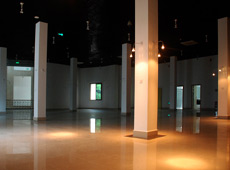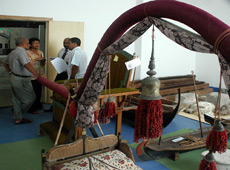Luxury Maldivian resort Soneva Fushi is currently hosting a three day ‘Slow Life’ symposium bringing together big names in business, climate science, film and renewable energy to come up with ways to address climate change.
Attendees at the Symposium include famous UK entrepreneur Richard Branson, founder of the Virgin Empire; actress Daryl Hannah, star of films including ‘Blade Runner’, ‘Kill Bill’ and ‘Splash’; Ed Norton, star of films including ‘Fight Club’ and ‘American History X’; Tim Smit, founder of the Eden Project; Maldives President Mohamed Nasheed; and an array of climate experts and scientists including Mark Lynas and Mike Mason.
Richard Branson
Branson described how six years ago former US Vice President and environmental advocate Al Gore arrived at his house “and made me realise I had to make changes to the way I was doing business in the own world.”
Among other initiatives, Branson described his creation of a “Carbon War Room” funding scientific work into both climate education and the development of a renewable alternative to jet fuel.
“Ethanol was not a good idea because it freezes at 15,000 feet,” Branson noted. “So we’re investigating alternatives such as algae, isobutanol and fuel created from eucalyptus trees,” he said, adding that Virgin would be making a significant announcement on the subject next week.
Big business had the ability and prerogative to break down market barriers to the development of low carbon technologies, he said. Inefficient shipping, for instance, wasted US$70 billion a year, and led him to create a website allocating ratings to the most efficient vessels and ports, that had attracted interest from large grocery chains.
Branson also outlined his US$25 million prize for the development of a commercial technology capable of removing carbon from the atmosphere, an idea he said was inspired by the 1714 prize offered for developing a means of measuring longitude on a ship, and had attracted thousands of innovative ideas.
President Mohamed Nasheed
Speaking at the symposium on Saturday, Nasheed said it was “very clear, that regardless of whether you are rich or poor, too much carbon will kill us.”
“For us, this is not just an environmental issue. We need to become carbon neutral even if there was no such thing as climate change, simply because it is more economically viable. We spend more than 14 percent of our GDP on fossil fuel energy, which is more than our education and health budget combined.”
The most important adaptation measure, Nasheed said, “is democracy. You have to have a responsive government to discuss this issue. When I do something people do not believe in, they shout at me. But they are not doing this on this issue.”
The government had reformed its economic system and introduced new taxes “so we can fend for ourselves. We cannot endlessly rely on the international community.”
Since last year’s symposium the government had launched its renewable energy investment plan, and contracted an international firm to process waste at Thilafushi, Nasheed said, as well as introduced a feed in tariff which would make generating solar “more profitable than a corner shop.”
“If you are buying electricity at 40 cents a kilowatt hour you can sell electricity to the state at 35 cents. Soneva Fushi is going to be able to produce electricity with solar at 15 cents. We will be able to finance households as a loan to pay back from savings they are making. If you do the sums in the Maldives it is really quite possible, and I’m confident that households will see the commercial viability.”
Ed Norton
Meanwhile Ed Norton, star of films including ‘Fight Club’ and ‘American History X’, linked sanitation and waste management to human development, noting that more people had cell phones than toilets. As a result, Norton said, 1.7 million people died yearly of preventable diarrheal diseases – 90 percent of them under the age of five.
“The World Health Organisation estimates that for every dollar spent on sanitation, $3-34 is returned to the economy,” he observed.
Ocean dumping of sewage was standard, he noted, while septic tanks could leak and contaminate groundwater. He proposed a greater focus on using waste water for fertiliser and water recycling, rather than thinking of it simply as a matter of waste disposal.
Jonathan Porritt
UK environmentalist Jonathan Porritt, founder of Forum for the Future, observed that just by attending the Symposium he had contributed four tons of carbon dioxide to the atmosphere.
He referred to a colleague who was “so overwhelmingly conscious” of his carbon footprint that he weighed his attendance at such events by “the gravity of the audience, the quality of his speech and the effectiveness in lobbying and networking.”
However, he noted that travel and tourism was, overall, a “force for good in an increasingly troubled world.”
“We live in a world where governments invest US$1.4 trillion a year in war. We live in a world where US$4 trillion is invested in the war against terror, a world were fundamentalism is rampant and aggressive nationalism is all over the place. Many countries taking a lead on the issue suffer from a deep sense of exhaustion. Against that backdrop, hands-on [tourism] is a way to bridge the divide,” Porritt said.
At the same time tourism was driven by the balance sheet, and that while there was a great deal of ecotourism initiatives much of it was “marketing, with no credibility.”
“There is a focus on green rather than sustainable tourism, and no real understanding of what it means,” he said. “There is a reluctance to engage on socio-economic issues.”
“Gaps in equity are widening – and the gap between the have and the have nots is widening. Even as tourism contributes economically, because of the gaps resentment about the impact of the industry is rising – especially in a country where access to land, water, beachfront, reef and biomass is being privileged to support growth of tourism industry rather than the interests of local people.”
Tourism, Porritt said, was a microcosm of the local economy, with high end tourism such as that in the Maldives attracting the wealthiest and most influential people.
“For the one percent of the population that control more than 30 percent of the net wealth in a country such as the United States, it is very easy to insulate one’s self from real world by traveling from high security offices to gated communities to privileged, luxury resorts. It is a bubble through which the real world rarely penetrates.”
A state of low carbon with high inequality was “not a judgement anyone should be comfortable with. We should be thinking not just about the need to mitigate carbon impact, but offsetting inequality. I think what we are doing should be from the perspective of social justice as much as low carbon.”
However, he noted, it was easier to educate a few billionaires than the entire population of a country such as the US, distracted from the issue by Xboxes and cable TV.
“Billionaires have a vested interest in keeping the [planet sustainable], because they have enough money enjoy the planet,” he suggested.
Tim Smit
Founder of the Eden Project in Cornwall, Tim Smit, spoke about the need to mobilise people by capturing their imagination – and the responsibility the Maldives has as a symbol of a united effort combating climate change.
“Author CS Lewis said that while science leads to truth, only imagination leads to meaning,” Smit said.
“We are used to talking to halls of middle aged men who want to be inspired. We read the books about affecting change and they have the same language, and it is really dull: paradigm shifts, centres of excellence, leading edge thinking, cutting edge thinking, and when they are very excited, bleeding edge thinking. We don’t write books about the impact of this thinking.”
Incredible things, Smit said, were “being done by the unreasonable.”
“The Maldives has captured the imagination, and the elected political elite are showing charisma and leadership on the issue [of climate change]. The danger is that we listen to too many middle aged white people, and miss the point. I see an incredible moment when the story of Maldives becomes the story of us all – but it needs to be delivered with a pirate grin that says f*** it, we’re going to do this thing. I hate idealists. I like unreasonable people who do things.”
There was, Smit said, a danger that the Maldives would lose sight of its goal, and “lose the moment when the Maldives could become the most important place in world. The goal is open but the moment will be gone, and suddenly the bright future is no longer there, just a job – and not a job in the spotlight.”
The Maldivian people needed to be given the independence to make their own decisions, such as installing solar, and given control so that they knew the impact of flipping the light switch.
“Trust in the people of the Maldives to get excited of a picture of the Maldives reborn,” Smit suggested.
The Slow Life Symposium continues on Sunday.


